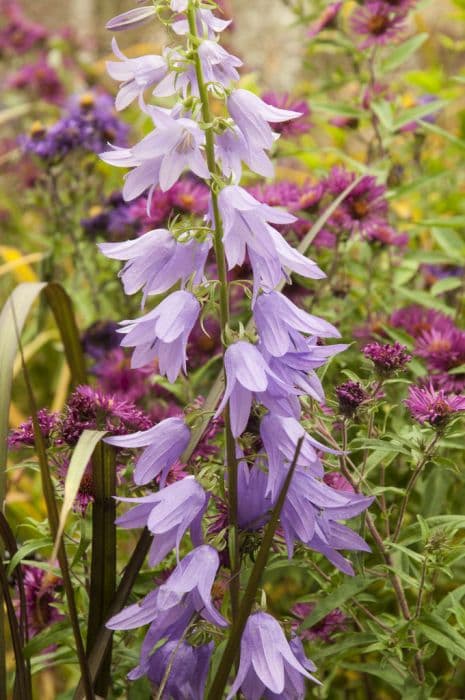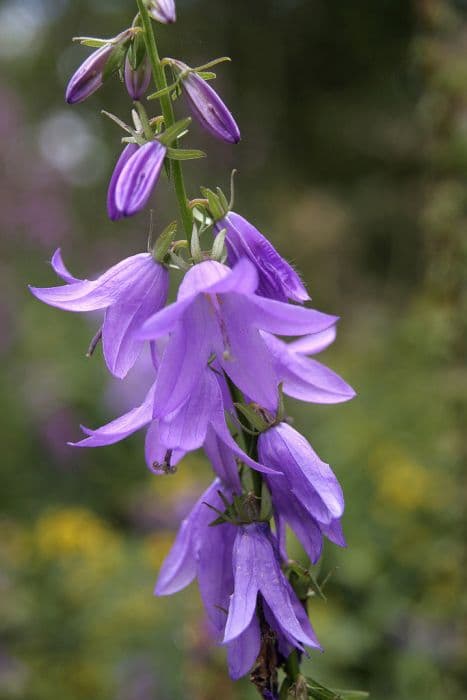Spotted Bellflower Campanula punctata f. rubriflora 'Wine 'n' Rubies'

ABOUT
Campanula punctata f. rubriflora 'Wine 'n' Rubies', commonly known as bellflower, is a perennial plant distinguished by its striking flowers and foliage. The flowers are shaped like broad bells with flared edges, starting as tightly furled buds and opening into a mesmerizing display. These blooms have a deep, reddish-pink hue with a spotted or speckled texture on the inside, creating an intriguing pattern that adds to the plant's allure. The petals have a tendency to curl back slightly, giving the flowers a playful, almost whimsical look. This colorful display is set against a backdrop of deep green leaves, which are heart-shaped with sharp-toothed margins and a lush, sometimes glossy appearance. The foliage provides a perfect contrast to the vivid colors of the flowers, enhancing their visual impact. The entire plant exudes a rustic charm with its intriguing color combination and the way it presents its blossoms, making it a captivating sight in any garden setting.
About this plant
 Names
NamesFamily
Campanulaceae.
Synonyms
Spotted Bellflower, Cherry Bells, Wine And Rubies Campanula.
Common names
Campanula punctata f. rubriflora 'Wine 'n' Rubies'.
 Toxicity
ToxicityTo humans
The plant commonly known as Spotted bellflower is generally not considered toxic to humans. However, individual sensitivity to plants can vary, and it's always advisable to avoid ingesting plants that are not meant for consumption as they may cause an upset stomach or allergic reactions in some individuals.
To pets
The Spotted bellflower is also not commonly known to be toxic to pets. As with humans, pets may have individual sensitivities, and consumption of non-food plants can potentially lead to gastrointestinal discomfort or possible allergic reactions. It is always prudent to keep an eye on pets and prevent them from eating ornamental plants.
 Characteristics
CharacteristicsLife cycle
Perennials
Foliage type
Deciduous
Color of leaves
Green
Flower color
Pink
Height
1-2 feet (30-60 cm)
Spread
1-2 feet (30-60 cm)
Plant type
Herb
Hardiness zones
4
Native area
Asia
Benefits
 General Benefits
General Benefits- Ornamental Appeal: The vibrant flowers add aesthetic value to gardens and landscapes.
- Attracts Pollinators: Flowers provide nectar that attracts bees, butterflies, and other beneficial insects.
- Low Maintenance: Once established, it requires minimal care, making it suitable for busy gardeners.
- Drought Tolerance: It can withstand periods of dryness once fully grown, reducing the need for frequent watering.
- Cold Hardy: This plant can survive in colder climates, making it a good choice for northern gardens.
- Fast Growing: It covers ground quickly, which can help with erosion control and filling in garden spaces.
- Versatile Planting: Suitable for borders, rock gardens, and underplanting beneath shrubs and tall perennials.
 Medical Properties
Medical PropertiesThis plant is not used for medical purposes.
 Air-purifying Qualities
Air-purifying QualitiesThis plant is not specifically known for air purifying qualities.
 Other Uses
Other Uses- Crafting floral jewelry: The delicate blossoms of the Spotted Bellflower can be carefully dried and used to create unique handcrafted earrings, necklaces, and brooches.
- Edible Garnish: The flowers of the Spotted Bellflower are edible and can add a touch of color and unique flavor to salads, desserts, and cocktails.
- Photography subject: Due to its striking appearance, the Spotted Bellflower is an excellent subject for botanical photographers and nature enthusiasts looking to capture its beauty.
- Icing decorations: The petals can be crystallized with egg white and sugar to create enchanting edible decorations for cakes and pastries.
- Artistic inspiration: Artists may use the Spotted Bellflower as a muse or model for paintings, drawings, and other forms of botanical illustration.
- Textile design: The unique pattern of the Spotted Bellflower can serve as an inspiration for textile prints in the fashion industry.
- Botanical studies: Botany students and hobbyists can study the Spotted Bellflower to learn about its growth pattern, reproduction, and unique characteristics within the Campanula genus.
- Dye production: Some flowers are traditionally used in natural dye making, and while less common, the Spotted Bellflower could potentially lend its hues to the creation of natural dyes.
- Theme gardens: Gardeners can use the Spotted Bellflower as part of a wine-themed garden, due to its 'Wine 'n' Rubies' variety name, adding a playful aspect to their horticultural designs.
- Culinary exploration: The leaves of the Spotted Bellflower could be experimented with in culinary contexts, similar to other edible Campanula relatives, although they are less commonly consumed.
Interesting Facts
 Feng Shui
Feng ShuiThe Spotted Bellflower is not used in Feng Shui practice.
 Zodiac Sign Compitability
Zodiac Sign CompitabilityThe Spotted Bellflower is not used in astrology practice.
 Plant Symbolism
Plant Symbolism- Gratitude: Bellflowers, including Campanula punctata, often symbolize gratitude due to their bell shape that appears to bow down as if expressing thanks.
- Constancy and Perseverance: The Campanula's ability to thrive in various conditions reflects the qualities of constancy and perseverance.
- Unwavering Love: The long-lasting nature of the bellflower's bloom is frequently associated with the theme of unwavering and everlasting love.
 Water
WaterThe Spotted Bellflower should be watered deeply once the top inch of soil feels dry to the touch, which typically amounts to once or twice a week depending on weather conditions. Use room temperature water and slowly pour it around the base of the plant, allowing it to soak into the soil and reach the roots without flooding the area. For an average-sized plant, this usually means using approximately 1 gallon of water per session during active growth periods in spring and summer. In the fall and winter, reduce watering to every other week, being careful not to overwater as the plant's water needs decrease.
 Light
LightThe Spotted Bellflower thrives in bright, indirect light or partial shade conditions. It should be placed in a location where it receives morning sun and afternoon shade, especially in hotter climates, to protect it from the intense midday sun. An eastern or northern exposure is often ideal, offering the gentle sunlight this plant prefers.
 Temperature
TemperatureThe Spotted Bellflower prefers temperatures between 60 to 75 degrees Fahrenheit during the day and should not be exposed to temperatures below 50 degrees Fahrenheit. The plant can tolerate a brief dip just below this range but sustained cold can be damaging. It's ideal for growing in USDA hardiness zones 4 through 7, where outdoor temperatures typically fall within its preferred range.
 Pruning
PruningThe Spotted Bellflower benefits from pruning to remove spent flowers and encourage a second blooming, as well as to maintain its shape and prevent it from becoming leggy. It is best pruned after the primary flowering in early summer and can be cut back again in fall if necessary. Deadheading, or the removal of faded blooms, should be done regularly throughout the blooming season.
 Cleaning
CleaningAs needed
 Soil
SoilSpotted bellflower thrives in well-draining soil mixed with compost and peat for moisture retention, with a pH between 6.0 and 7.5.
 Repotting
RepottingSpotted bellflower should be repotted every 2-3 years or when it outgrows its current pot.
 Humidity & Misting
Humidity & MistingSpotted bellflower prefers average to high humidity but is adaptable to typical indoor levels.
 Suitable locations
Suitable locationsIndoor
Provide bright indirect light and keep soil moist.
Outdoor
Place in partial shade and protect from strong winds.
Hardiness zone
4-9 USDA.
 Life cycle
Life cycleCampanula punctata f. rubriflora 'Wine 'n' Rubies', commonly known as Cherry Bells, begins its life cycle as a seed, typically sown in spring when soil temperatures warm up. The seeds germinate, and seedlings emerge, gradually developing a rosette of basal leaves. As the plant matures, it sends up flowering stems in early to mid-summer, where bell-shaped, reddish-pink flowers bloom and attract pollinators. After pollination, these flowers develop into fruit capsules containing seeds, which can be dispersed by wind or wildlife. Once the flowering phase concludes, the plant’s above-ground foliage dies back, especially in colder climates, with the root system remaining dormant during winter. Cherry Bells is a perennial, thus it will regrow from the rootstock the following spring to repeat its life cycle.
 Propogation
PropogationPropogation time
Spring-Early Summer
Propogation: The most popular method for propagating Campanula punctata f. rubriflora 'Wine 'n' Rubies', commonly known as Spotted bellflower, is through division. The ideal time to divide this plant is in spring or early fall when the weather is cool and the plant is not in active bloom. To propagate by division, carefully dig up the entire clump of the plant, making sure to keep as much of the root system intact as possible. Then, using a sharp knife or spade, divide the clump into smaller sections, each with several shoots and a portion of the root system. Replant the divisions at the same depth they were originally growing at, spacing them about 12 inches (30 centimeters) apart to allow for spread. Water the new plants thoroughly to help establish them. This method of propagation helps to rejuvenate older clumps, encourages vigorous growth, and allows gardeners to multiply their plants effectively.








